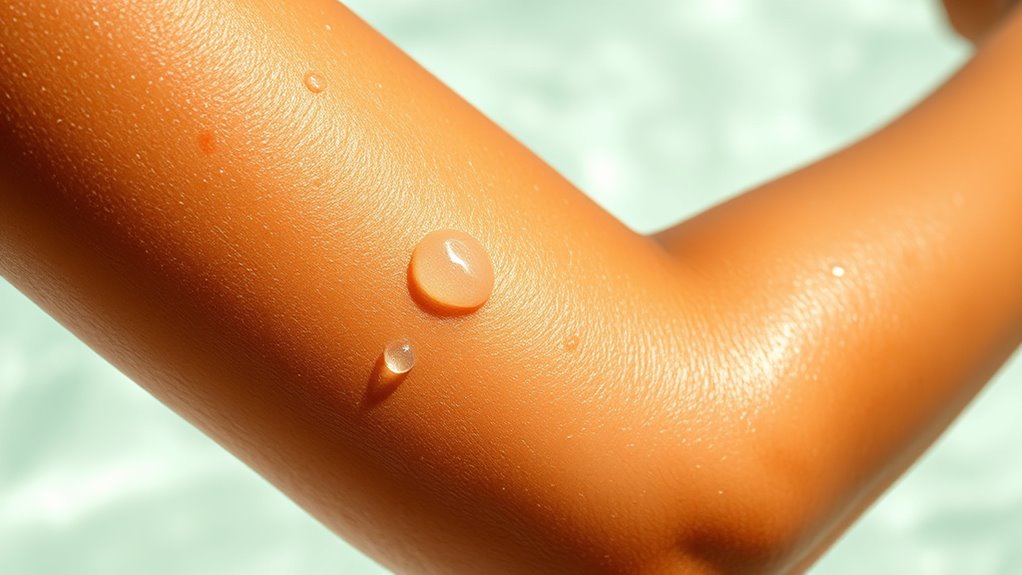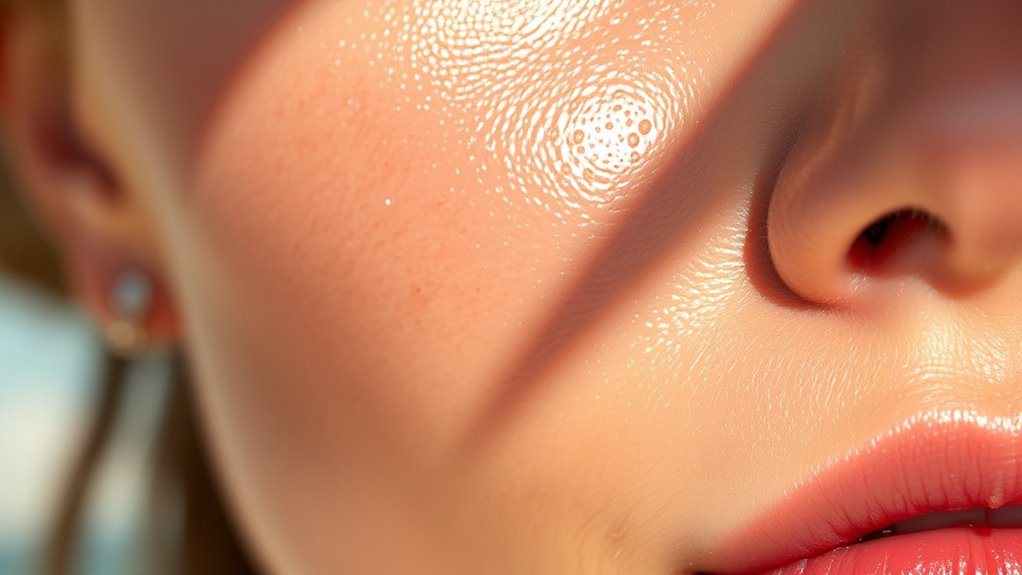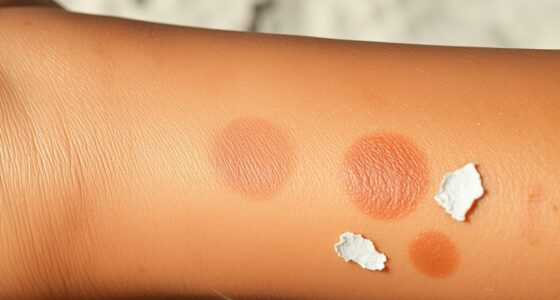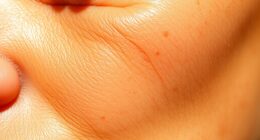After sun exposure, it’s important to prioritize hydration and gentle healing to protect your skin. Replenish lost moisture with plenty of water and use soothing products like aloe vera gel or fragrance-free lotions. Avoid harsh cleansers or hot showers, and opt for soft, protective clothing to minimize further damage. Keeping your skin calm and well-hydrated helps it recover faster and stay healthy, so you can enjoy your glow longer. If you want to learn more, there’s helpful advice ahead.
Key Takeaways
- Rehydrate skin by drinking plenty of water and applying aloe vera gel to soothe and promote healing.
- Use gentle, fragrance-free cleansers and avoid harsh exfoliants immediately after tanning.
- Apply broad-spectrum moisturizer with SPF daily to protect and support skin recovery outdoors.
- Limit sun exposure and wear protective clothing to prevent further UV damage during healing.
- Incorporate antioxidants and nourishing ingredients to enhance skin repair and maintain long-term skin health.

After you’ve enjoyed a tan, taking proper care of your skin is vital to maintain its health and glow. Sun protection becomes your top priority because UV rays can continue to damage your skin even after you’ve stepped out of the sun. Use a gentle, broad-spectrum moisturizer with SPF to shield your skin from further UV exposure. This helps prevent premature aging, dark spots, and irritation. Remember, reapplying sunscreen throughout the day is imperative, especially if you’re spending extended time outdoors. Wearing protective clothing and seeking shade also supports your skin’s recovery process.
Hydration plays a key role in healing sun-exposed skin. Drinking plenty of water helps replenish moisture lost during sun exposure and keeps your skin plump and resilient. Topical hydration is equally important. After a tan, your skin may feel dry or tight, so opt for hydrating skincare products like aloe vera gel or lotions rich in humectants. Aloe vera, in particular, is renowned for its soothing, healing properties. Applying pure aloe vera gel directly onto your skin can reduce redness, calm inflammation, and accelerate the repair process. Its natural antioxidants help combat free radicals generated by UV exposure, supporting skin regeneration.
Hydrate internally and topically with aloe vera to soothe, heal, and support your sun-exposed skin.
Avoid harsh cleansers or exfoliants immediately after tanning, as they can strip away your skin’s natural oils and cause irritation. Instead, stick to mild, fragrance-free cleansers that cleanse without disrupting your skin’s barrier. Incorporate nourishing ingredients like aloe vera into your routine to enhance healing. If your skin feels inflamed or irritated, don’t hesitate to use aloe vera multiple times a day. Its cooling effect offers instant relief and promotes faster recovery. Additionally, staying away from hot showers and baths helps prevent further dehydration of your skin. Opt for lukewarm water and gentle patting instead of rubbing.
It’s also wise to give your skin time to recover by avoiding further sun exposure. Cover up with clothing or seek shade if you need to go outside. This not only prevents additional damage but also allows your skin to heal naturally. Understanding city dynamics and local conditions can help you better plan your outdoor activities and protect your skin. Remember, tanning is a sign of skin stress, and proper post-tan care is about nurturing and supporting your skin’s natural healing process. Incorporating sun protection strategies and healing ingredients like aloe vera into your routine ensures your skin remains vibrant and healthy long after your tan fades. By being gentle and attentive to your skin’s needs, you’ll enjoy a radiant glow that lasts, free from irritation or damage.
Frequently Asked Questions
Can I Exfoliate Immediately After Tanning?
You shouldn’t exfoliate immediately after tanning because your skin is more sensitive and prone to irritation. Exfoliation timing is key, and waiting a few days allows your skin to recover. Skin sensitivity considerations suggest gentle exfoliation once the initial redness and discomfort subside—usually after 48-72 hours. This approach helps prevent damage, irritation, and guarantees your skin heals properly, keeping your tan looking fresh and your skin healthy.
Are There Specific Products for Sensitive Post-Tan Skin?
If you have sensitive skin after tanning, you should look for hypoallergenic products designed specifically for delicate skin. These products help reduce irritation and support healing without causing additional redness or discomfort. Always choose gentle cleansers, moisturizers, and soothing ingredients like aloe or chamomile. Avoid harsh chemicals, fragrances, and alcohol, which can aggravate sensitive skin. Using targeted, sensitive skin-friendly products guarantees your skin stays calm, hydrated, and heals properly after sun exposure.
How Long Should I Wait Before Reapplying Sunscreen?
You might worry about reapplying sunscreen too often, but it’s essential for your skin’s health. Generally, you should reapply sunscreen every two hours, especially during the tanning timeline or if you’re swimming or sweating. Don’t wait too long—reapplying guarantees continuous protection from UV rays and helps maintain your tan safely. Keep a bottle handy and make it part of your routine to stay protected and enjoy your time outdoors.
Is It Safe to Use Retinol on Sun-Exposed Skin?
You might wonder if retinol safety is compromised after sun exposure. It’s best to avoid using retinol on sun-damaged skin, as it can increase sensitivity and irritation. Sun damage weakens your skin’s barrier, making retinol more risky. Wait until your skin heals and recovers from sun exposure before reintroducing retinol into your routine. Protect your skin with sunscreen and hydration to support healing and maintain safety.
What Natural Remedies Aid in Skin Healing After Tanning?
Ever notice how natural remedies seem to appear just when you need them? For skin healing after tanning, natural aloe is your best friend—cool and soothing, it reduces inflammation and hydrates deeply. Honey healing works wonders too, thanks to its antibacterial and antioxidant properties. Together, these remedies help your skin recover faster, keeping it nourished and protected while your tan fades naturally.
Conclusion
Think of your skin as a delicate garden that needs gentle care after sun exposure. Hydrate it like watering tender roots, and heal it like nurturing a wilting blossom. With patience and love, you’ll restore your skin’s health, allowing it to bloom again. Remember, each caring act is a drop of rain, nourishing your skin’s journey back to vibrancy. Embrace this ritual, and watch your glow return, brighter and stronger than before.









